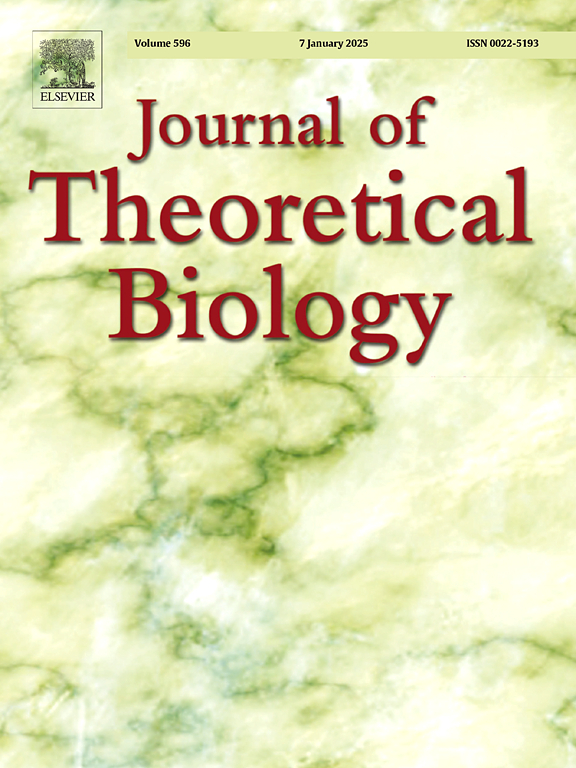Mating versus alternative blood sources as determinants to mosquito abundance and population resilience
IF 2
4区 数学
Q2 BIOLOGY
引用次数: 0
Abstract
A deterministic nonlinear ordinary differential equation model for mosquito dynamics in which the mosquitoes can quest for blood either within a human population or within non-human/vertebrate populations is derived and studied. The model captures both the mosquito’s aquatic and terrestrial forms and includes a mechanism to investigate the impact of mating on mosquito dynamics. The model uses a restricted form of homogeneous mixing based on the idea that the mosquito has a blood-feeding habit determined by its blood-feeding preferences and its gonotrophic cycle. This characterisation allows us to compartmentalise the total mosquito population into distinct compartments according to the spatial location of the mosquito (breeding site, resting places and questing places) as well as blood-fed status. Issues of overcrowding and intraspecific competition both within the aquatic and the terrestrial stages of the mosquito’s life forms are addressed and considered in the model. Results show that the inclusion of mating induces bistability, a phenomenon whereby locally stable trivial and non-trivial equilibria co-exist with an unstable non-zero equilibrium. The local nature of the stable equilibria is demonstrated by numerically showing that the long-term state of the system is sensitive to initial conditions. The bistability state is analogous to the phenomenon of the Allee effect that has been reported in population biology. The model’s results, including the derivation of the threshold parameter of the system, are comprehensively tested via numerical simulations. The output of our model has direct application to mosquito control strategies, for it clearly shows key points in the mosquito’s developmental pathway that can be targeted for control purposes.
交配与替代血液来源是蚊子数量和种群恢复力的决定因素。
本文推导并研究了蚊子在人类种群或非人/脊椎动物种群中吸血的确定性非线性常微分方程模型。该模型捕获了蚊子的水生和陆地形态,并包括一种机制来研究交配对蚊子动力学的影响。该模型使用了一种有限形式的均匀混合,其基础是蚊子的吸血习惯是由它的吸血偏好和淋养循环决定的。这种特征使我们能够根据蚊子的空间位置(繁殖地点、休息地点和探索地点)以及吸血状况将蚊子总数划分为不同的区域。该模型解决并考虑了蚊子在水生和陆地生命形式阶段的过度拥挤和种内竞争问题。结果表明,配合的包含引起双稳定性,即局部稳定的平凡平衡和非平凡平衡与不稳定的非零平衡共存的现象。用数值方法证明了系统的长期状态对初始条件敏感,从而证明了系统稳定平衡的局部性质。双稳状态类似于种群生物学中报道的Allee效应现象。通过数值模拟对模型结果进行了全面验证,包括系统阈值参数的推导。我们的模型的输出可以直接应用于蚊子控制策略,因为它清楚地显示了蚊子发育途径中的关键点,可以用于控制目的。
本文章由计算机程序翻译,如有差异,请以英文原文为准。
求助全文
约1分钟内获得全文
求助全文
来源期刊
CiteScore
4.20
自引率
5.00%
发文量
218
审稿时长
51 days
期刊介绍:
The Journal of Theoretical Biology is the leading forum for theoretical perspectives that give insight into biological processes. It covers a very wide range of topics and is of interest to biologists in many areas of research, including:
• Brain and Neuroscience
• Cancer Growth and Treatment
• Cell Biology
• Developmental Biology
• Ecology
• Evolution
• Immunology,
• Infectious and non-infectious Diseases,
• Mathematical, Computational, Biophysical and Statistical Modeling
• Microbiology, Molecular Biology, and Biochemistry
• Networks and Complex Systems
• Physiology
• Pharmacodynamics
• Animal Behavior and Game Theory
Acceptable papers are those that bear significant importance on the biology per se being presented, and not on the mathematical analysis. Papers that include some data or experimental material bearing on theory will be considered, including those that contain comparative study, statistical data analysis, mathematical proof, computer simulations, experiments, field observations, or even philosophical arguments, which are all methods to support or reject theoretical ideas. However, there should be a concerted effort to make papers intelligible to biologists in the chosen field.

 求助内容:
求助内容: 应助结果提醒方式:
应助结果提醒方式:


